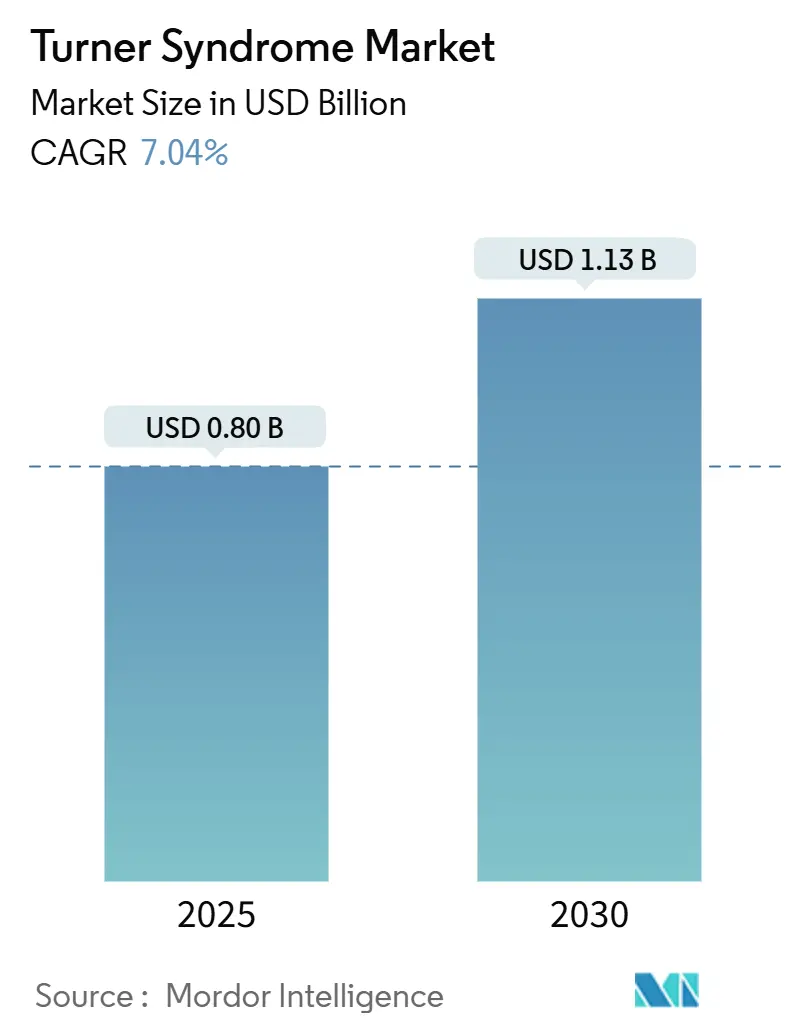
| Study Period | 2019 - 2030 |
| Market Size (2025) | USD 0.8 Billion |
| Market Size (2030) | USD 1.13 Billion |
| CAGR (2025 - 2030) | 7.04 % |
| Fastest Growing Market | Asia Pacific |
| Largest Market | Americas |
| Market Concentration | Medium |
Major Players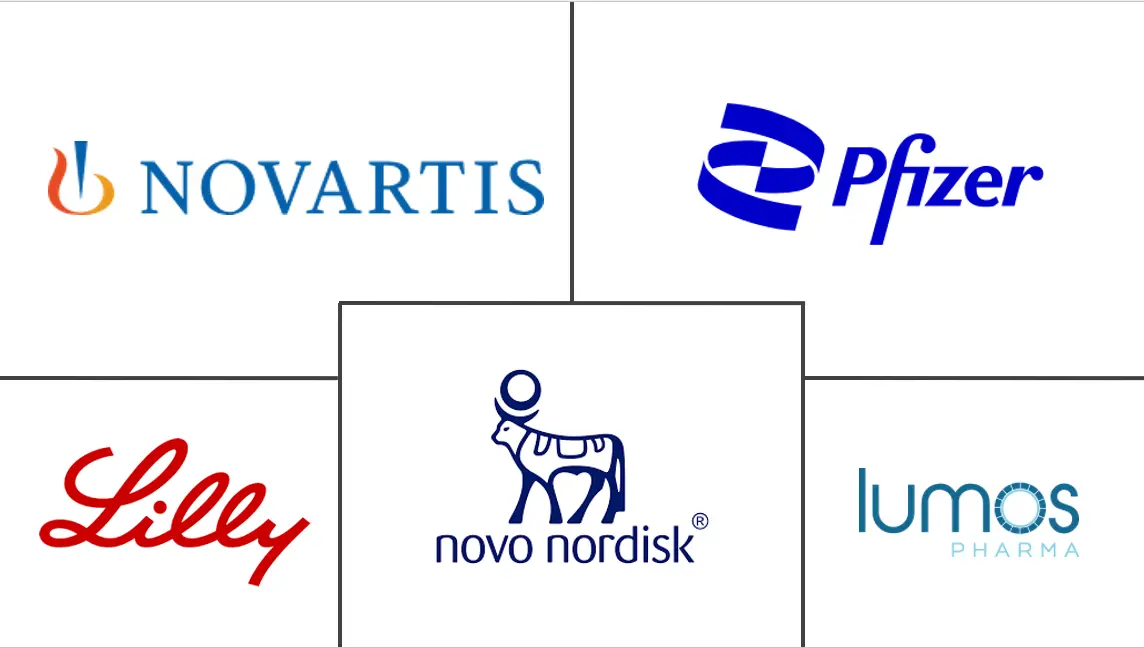
*Disclaimer: Major Players sorted in no particular order |
Turner Syndrome Market Analysis
The Turner Syndrome Market size is estimated at USD 0.80 billion in 2025, and is expected to reach USD 1.13 billion by 2030, at a CAGR of 7.04% during the forecast period (2025-2030).
Turner syndrome is a genetic condition that affects females and results from the complete or partial absence of one X chromosome. The increasing prevalence of Turner syndrome is contributing to market growth. For instance, a study published in Pediatric Medicine in May 2023 highlighted that Turner syndrome (TS) occurs in approximately one out of every 2,500 to 4,000 live-born females worldwide. It is characterized by traits like short stature, ovarian insufficiency, heart defects, autoimmune disorders, low bone density, and a higher likelihood of developing insulin resistance and type 2 diabetes. These factors underscore the importance of advancing research and treatment options for Turner syndrome to address its associated challenges effectively.
In addition, infertility is prevalent in women with Turner syndrome due to ovarian dysgenesis, low egg count, and uterine abnormalities. For instance, according to a study published in the BMC Pregnancy and Childbirth Journal in September 2024, analyzed live birth rates and pregnancy outcomes in 417 patients across 14 studies. The findings showed a 40% live birth rate per patient and a 17% rate per embryo transfer cycle, with 31% achieving clinical pregnancy per cycle. Additionally, 12% of pregnancies experienced hypertensive complications. These results highlight the challenges and risks associated with pregnancy in Turner syndrome patients.
Advancements in fertility treatments, particularly non-invasive prenatal testing (NIPT), are driving market growth. NIPT is a safe and effective blood test used during the first trimester to detect chromosomal abnormalities like Down syndrome, Turner syndrome, and Edward syndrome. It provides early and accurate insights, helping expectant parents make informed decisions. For instance, according to a study published in BMC Pregnancy and Childbirth in January 2024 analyzed NIPT's effectiveness in detecting fetal sex chromosome aneuploidies (SCAs) among 9,176 Korean pregnant women. The study identified 46 SCA-positive cases, including 20 Turner syndrome cases, 12 triple X syndrome cases, 8 Klinefelter syndrome cases, and 6 Jacob syndrome cases. Among 37 women who underwent invasive prenatal diagnosis, 19 cases were confirmed as true positives. The overall positive predictive value (PPV) of NIPT for SCAs was 51.35%, with specific PPVs of 18.75% for Turner syndrome. These findings highlight NIPT's clinical utility in identifying chromosomal abnormalities, reinforcing its role as a transformative tool in prenatal care and supporting its growing adoption in the market.
As a result, factors such as the increasing prevalence of Turner syndrome, the growing number of infertility cases linked to the condition, and advancements in fertility treatment technologies are expected to drive the growth of the Turner Syndrome Market during the forecast period. These elements collectively highlight the rising demand for effective diagnostic and therapeutic solutions. In conclusion, the market is poised for significant expansion as awareness and medical innovations continue to address the challenges associated with Turner syndrome.
However, the high cost of treatment, side effects of hormonal therapies and limited awareness about Turner syndrome in underdeveloped regions restrain the market growth.
Turner Syndrome Market Trends
Growth Hormone Therapy Segment is Expected to Witness Significant Growth Over the Forecast Period
Growth hormone therapy is a standard treatment for individuals with Turner syndrome. This therapy has proven to be an effective approach for enhancing the development of individuals with Turner syndrome. Short stature is a prominent characteristic of Turner Syndrome (TS). The primary goal of growth hormone (GH) therapy is to assist individuals with TS in achieving an adult height (AH) that aligns with the average height observed in the general female population. This treatment not only addresses physical growth challenges but also significantly improves the overall quality of life and mental well-being of patients, emphasizing the necessity of early and effective intervention.
For instance, an article published in Clinical Therapeutics of Elsevier Journal in February 2024 highlights that the recommended GH dosage for girls with TS typically ranges from 45 to 50 µg/kg per day, with adjustments up to 68 µg/kg per day in cases where AH predictions are notably low. These findings underscore the importance of personalized treatment strategies to maximize therapeutic benefits and ensure better long-term outcomes for individuals with TS.
The industry is witnessing a notable rise in geographical expansion strategies aimed at broadening market reach. For instance, in January 2022, Ascendis Pharma A/S obtained approval from the European Commission for its product, TransCon hGH. This innovative therapy is specifically developed for pediatric patients suffering from growth hormone deficiency and incorporates somatropin, a synthetic form of human growth hormone. The European Commission's approval signifies that TransCon hGH has met stringent regulatory standards, enabled its commercialization and use across the European Union. Such advancements not only improve access to essential treatments but also drive market growth by addressing unmet medical needs and fostering innovation in the healthcare sector.
Furthermore, the growing adoption of growth hormone therapy as a treatment option, coupled with the implementation of geographical expansion strategies by key players to enhance market penetration, is anticipated to drive significant growth in the segment over the forecast period. These strategies aim to address the increasing demand for effective treatments while expanding the availability of therapies across diverse regions, thereby contributing to the overall market development.
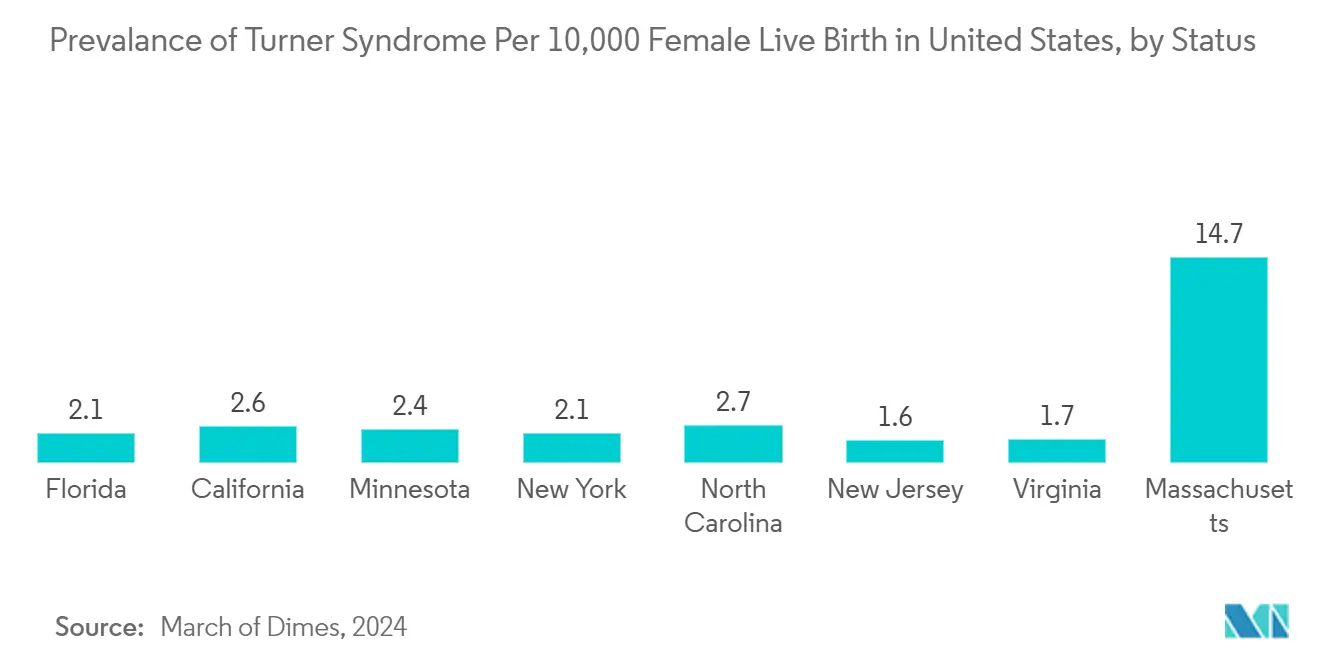
North America is Expected to Dominate the Turner Syndrome Market Over the Forecast Period
North America is anticipated to lead the Turner syndrome market due to several factors, including the high prevalence of the condition, advanced healthcare infrastructure, increased awareness campaigns, and the presence of key market players in the region.
For instance, according to a study published in Endocrinology Advisor, in April 2024, Turner syndrome poses unique challenges during pregnancy, requiring careful evaluation of associated risks. Researchers from the University of Southern California, Los Angeles, conducted a cross-sectional study using data from the Healthcare Cost and Utilization Project’s National Inpatient Sample, analyzing deliveries among women aged 15 to 54 years. The study examined maternal conditions like gestational hypertension, fetal factors such as intrauterine fetal demise, and delivery outcomes like cesarean rates. Among 17.86 million participants, 7.0 per 100,000 deliveries involved women with Turner syndrome, with a notable increase in delivery rates for this group. These findings emphasize the importance of tailored medical care for Turner syndrome patients during pregnancy.
Additionally, the market growth is supported by rising government initiatives and increasing awareness campaigns focused on Turner syndrome and related female health disorders. For example, in April 2024, the Turner Syndrome Foundation organized a program aimed at raising awareness about Turner syndrome. This initiative established a community dedicated to promoting awareness and achieving fundraising objectives. The funds raised are intended to support expanded research efforts, educational webinars, and the publication of informative articles to better educate both patients and healthcare professionals about the condition.
Turner syndrome, a genetic disorder that exclusively affects females, necessitates specialized and targeted treatment approaches to address its unique challenges. For instance, in May 2023, the Canadian Agency for Drugs and Technologies in Health (CADTH) emphasized the importance of the Implementation Advice Panel (IAP), which comprises experts and stakeholders, in resolving critical issues such as reimbursement policies and the appropriate duration of somatropin therapy. Somatropin, a growth hormone therapy approved for managing Turner syndrome, is available under various brands, including Genotropin, Humatrope, Norditropin, Omnitrope, and Saizen. These therapies are specifically designed to cater to the needs of pediatric patients with Turner syndrome, helping to manage growth deficiencies effectively. In conclusion, the availability of multiple somatropin brands ensures that individuals with Turner syndrome have access to diverse, effective, and tailored treatment options to improve their quality of life.
Key players in the market are actively working to expand their geographical footprint, which is expected to drive significant growth opportunities and positively impact the market's development in the region. For instance, in June 2023, the United States Food and Drug Administration (US-FDA) granted approval for Pfizer's NGENLA (somatrogon-ghla), a human growth hormone analog designed for once-weekly administration. This treatment is specifically indicated for pediatric patients aged three years and older who experience growth failure due to insufficient secretion of endogenous growth hormone. This approval marks a significant advancement in addressing growth hormone deficiencies in children, offering a more convenient treatment option and potentially improving patient adherence and outcomes. These strategic developments by key players highlight their commitment to addressing patient needs while strengthening their market presence.
As a result, the high prevalence of the condition, well-established healthcare infrastructure, growing awareness initiatives, specialized treatment options for Turner syndrome, and the presence of major market players in the region are expected to drive regional growth during the forecast period.
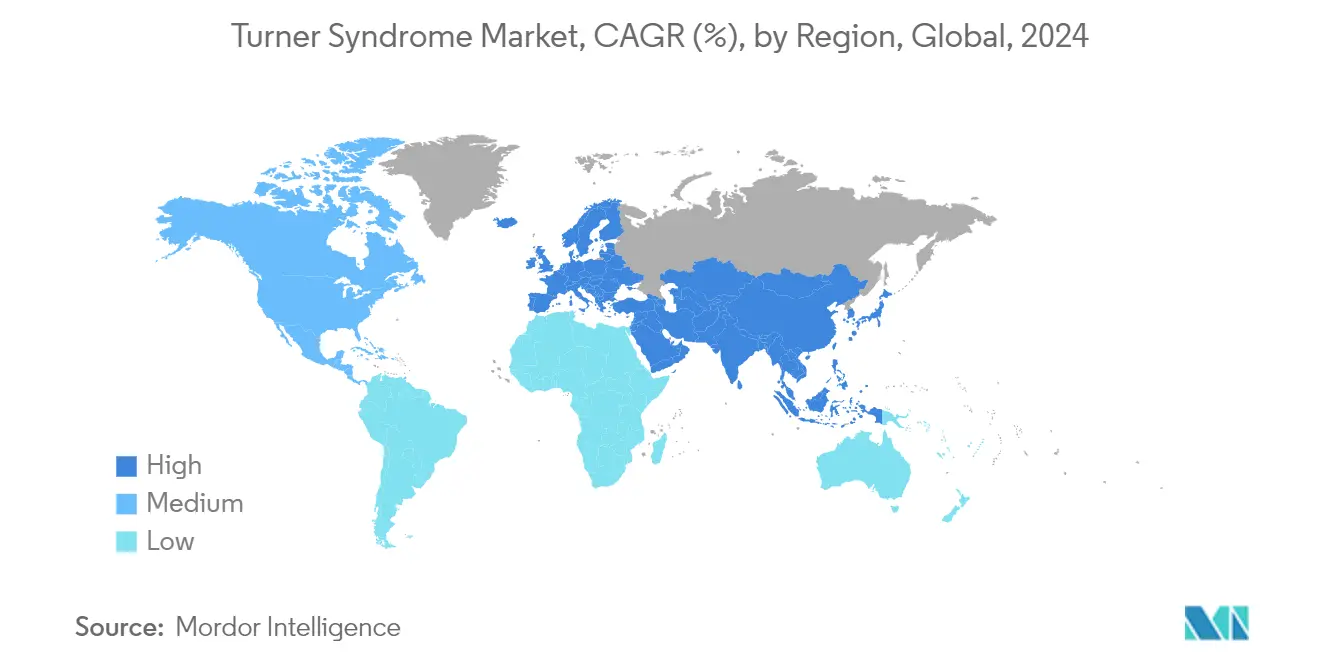
Turner Syndrome Industry Overview
The Turner syndrome market is categorized as semi-consolidated because a limited number of prominent companies dominate a significant portion of the market share. Key players such as Pfizer Inc., Novartis AG, Eli Lilly and Company, Novo Nordisk Inc., and Lumos Pharma are actively pursuing strategies like strategic partnerships, acquisitions, and continuous product innovation to strengthen their competitive position and expand their market reach.
Turner Syndrome Market Leaders
-
Pfizer Inc.
-
Novartis AG
-
Eli Lilly and Company
-
Novo Nordisk Inc.
-
Lumos Pharma
- *Disclaimer: Major Players sorted in no particular order
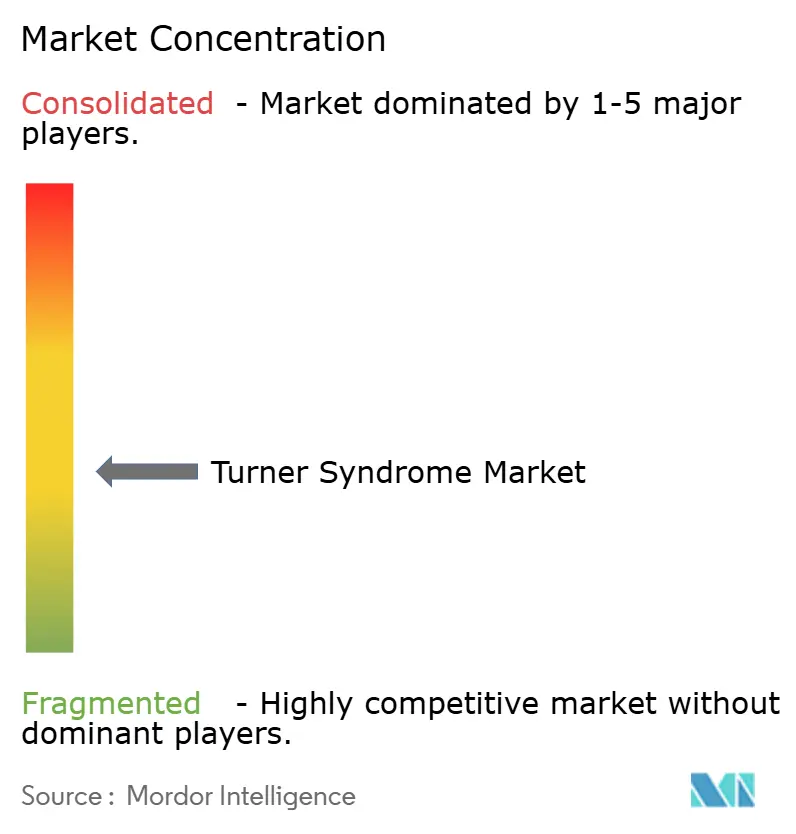
Turner Syndrome Market News
- December 2024: Ascendis Pharma A/S reported positive Week 26 results from its Phase 2 New InsiGHTS trial in the United States, which evaluated the safety, tolerability, and efficacy of once-weekly TransCon hGH (lonapegsomatropin) versus daily somatropin in prepubertal children with Turner syndrome. The study enrolled 49 children aged 1 to 10 years, divided into four groups receiving either one of three TransCon hGH doses (0.24, 0.30, or 0.36 mg/kg/week) or daily somatropin (0.35 mg/kg/week). The findings highlight the potential of TransCon hGH as a viable treatment option for Turner syndrome.
- May 2024: At the 26th European Congress of Endocrinology in Stockholm, Sweden, Jintrolong PEG-SOMATROPIN, developed by GenSci, was presented during the Growth Hormone Research Society (GRS) symposium. The product, a long-acting growth hormone (LAGH), was highlighted for its ability to reduce injection frequency and improve patient adherence. As the only LAGH available in China, Jintrolong has shown proven safety and effectiveness in treating conditions such as Growth Hormone Deficiency (GHD), Idiopathic Short Stature (ISS), Small for Gestational Age (SGA), and Turner Syndrome (TS). This advancement reinforces its role in improving treatment outcomes for growth-related disorders.
Turner Syndrome Industry Segmentation
Turner syndrome is a genetic disorder that exclusively affects females and arises due to the complete or partial absence of one X chromosome (sex chromosome). This condition is characterized by several medical and developmental challenges, including short stature, underdeveloped ovaries leading to infertility, and potential heart abnormalities. It represents a significant area of focus within the healthcare sector due to its impact on quality of life and the need for specialized medical interventions.
The Turner syndrome market is segmented into type, treatment type, route of administration, and geography. By type, the market is segmented into monosomy x (classic turner syndrome) and mosaic turner syndrome. By treatment type, the market is segmented into hormone therapy and others. By route of administration, the market is segmented into oral and injectables. By geography, the market is segmented into North America, Europe, Asia-Pacific, and Rest of the World. The report also offers the market size and forecasts for 17 countries across the region. For each segment, the market sizing and forecasts have been done on the basis of revenue (USD).
| By Type | Monosomy X (Classic Turner Syndrome) | ||
| Mosaic Turner Syndrome | |||
| By Treatment Type | Hormone Therapy | Growth Hormone Therapy | |
| Oestrogen and Progesterone Replacement Therapy | |||
| Others (Fertility Treatment, Psychological Therapy, etc) | |||
| By Route of Administration | Oral | ||
| Injectables | |||
| Geography | North America | United States | |
| Canada | |||
| Mexico | |||
| Europe | Germany | ||
| United Kingdom | |||
| France | |||
| Italy | |||
| Spain | |||
| Rest of Europe | |||
| Asia-Pacific | China | ||
| Japan | |||
| India | |||
| Australia | |||
| South Korea | |||
| Rest of Asia-Pacific | |||
| Rest of the World | |||
Turner Syndrome Market Research FAQs
How big is the Turner Syndrome Market?
The Turner Syndrome Market size is expected to reach USD 0.8 billion in 2025 and grow at a CAGR of 7.04% to reach USD 1.13 billion by 2030.
What is the current Turner Syndrome Market size?
In 2025, the Turner Syndrome Market size is expected to reach USD 0.8 billion.
Who are the key players in Turner Syndrome Market?
Pfizer Inc., Novartis AG, Eli Lilly and Company, Novo Nordisk Inc. and Lumos Pharma are the major companies operating in the Turner Syndrome Market.
Which is the fastest growing region in Turner Syndrome Market?
Asia Pacific is estimated to grow at the highest CAGR over the forecast period (2025-2030).
Which region has the biggest share in Turner Syndrome Market?
In 2025, the Americas accounts for the largest market share in Turner Syndrome Market.
What years does this Turner Syndrome Market cover, and what was the market size in 2024?
In 2024, the Turner Syndrome Market size was estimated at USD 0.74 billion. The report covers the Turner Syndrome Market historical market size for years: 2019, 2020, 2021, 2022, 2023 and 2024. The report also forecasts the Turner Syndrome Market size for years: 2025, 2026, 2027, 2028, 2029 and 2030.
Turner Syndrome Industry Report
Statistics for the 2025 Turner Syndrome market share, size and revenue growth rate, created by Mordor Intelligence™ Industry Reports. Turner Syndrome analysis includes a market forecast outlook for 2025 to 2030 and historical overview. Get a sample of this industry analysis as a free report PDF download.




